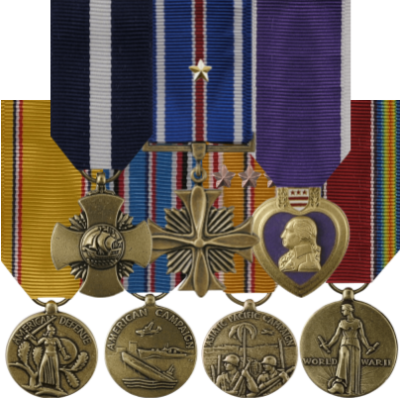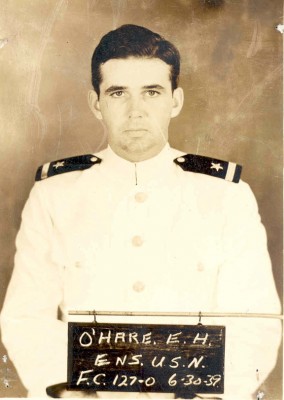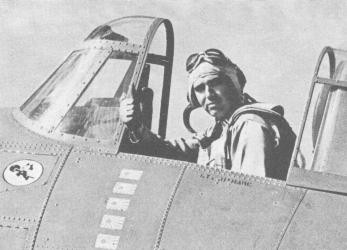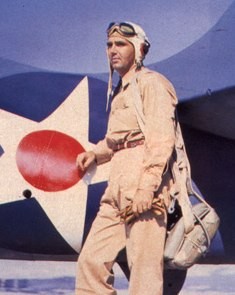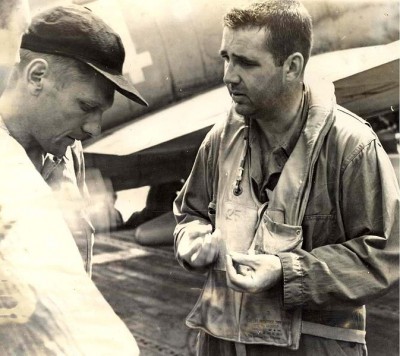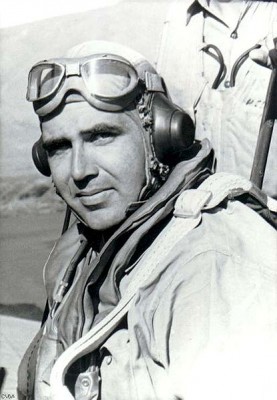| Příjmení: Surname: | O’Hare | O’Hare |
| Jméno: Given Name: | Edward Henry | Edward Henry |
| Jméno v originále: Original Name: | Edward Henry "Butch" O’Hare | |
| Fotografie či obrázek: Photograph or Picture: | | |
| Hodnost: Rank: | korvetní kapitán | Lieutenant Commander |
| Akademický či vědecký titul: Academic or Scientific Title: | - | - |
| Šlechtický titul: Hereditary Title: | - | - |
| Datum, místo narození: Date and Place of Birth: | 13.03.1914 St. Louis | 13.03.1914 St. Louis |
| Datum, místo úmrtí: Date and Place of Decease: | 26.11.1943 poblíž Gilbertových ostrovů | 26.11.1943 near Gilbert Islands |
| Nejvýznamnější funkce: (maximálně tři) Most Important Appointments: (up to three) | velitel, Palubní letecká skupina 6 velitel, VF-3/VF-6 | Commander, Carrier Air Group 6 Commander, VF-3/VF-6 |
| Jiné významné skutečnosti: (maximálně tři) Other Notable Facts: (up to three) | stíhací eso (7-1-0 vítězství) nositel Medaile cti padl v leteckém boji | Fighter Ace (7-1-0 claims) Recipient of Medal of Honor Killed in Air Battle |
| Související články: Related Articles: | | |
| Zdroje: Sources: | https://en.wikipedia.org/wiki/Butch_O'Hare | |
O'Hare, Edward Henry
| Příjmení: Surname: | O’Hare | O’Hare |
| Jméno: Given Name: | Edward Henry | Edward Henry |
| Jméno v originále: Original Name: | Edward Henry O’Hare | |
| Všeobecné vzdělání: General Education: | DD.MM.RRRR-DD.MM.RRRR | DD.MM.RRRR-DD.MM.RRRR |
| Vojenské vzdělání: Military Education: | DD.MM.RRRR-DD.MM.1932 Western Military Academy DD.MM.1933-03.06.1937 Námořní akademie Spojených států | DD.MM.RRRR-DD.MM.RRRR Western Military Academy DD.MM.RRRR-DD.MM.RRRR United States Naval Academy |
| Důstojnické hodnosti: Officer Ranks: | 03.06.1937 námořní praporčík DD.MM.RRRR námořní podporučík DD.MM.RRRR námořní poručík 08.04.1942 korvetní kapitán | 03.06.1937 Ensign DD.MM.RRRR Lieutenant Junior Grade DD.MM.RRRR Lieutenant 08.04.1942 Lieutenant-Commander |
| Průběh vojenské služby: Military Career: | | |
| Vyznamenání: Awards: | ||
| Poznámka: Note: | - | - |
| Zdroje: Sources: | https://en.wikipedia.org/wiki/Butch_O'Hare | |
Reklama
The Medal of Honor (Medal of Honor) is the highest American decoration. During World War II, 464 members of the Armed Forces received it; the first fighter pilot to receive it was Naval Aviator "Butch" O'Hare. He single-handedly faced a formation of Japanese bombers during the defense of the aircraft carrier Lexington and completely disrupted it with his attacks. The citation for that decoration then stated that he showed "remarkable bravery and intrepidity in aerial combat."
Lieutenant Commander Edward Henry "Butch" O'Hare
* 13.03.1914, St. Louis, Missouri
+ 26.11.1943, Tarawa
Edward O'Hare was born March 13, 1914 in St. Louis and had two sisters. His parents divorced in 1927 and his father Edward Joseph moved to Chicago, where he worked as a lawyer for AI Capone. He was later involved in his conviction for tax evasion and was shot dead in his car in November 1939. The children, however, remained with their mother Selma in Missouri. Young Edward first attended Western Military Academy and in 1933 began studying at the famous Naval Academy in Annapolis. He completed his studies on June 3, 1937, with the rank of Ensign.
Military Service to War
After graduation, Edward served two years on the battleship USS New Mexico (BB-40). In 1939, he entered pilot training at NAS Pensacola, Florida, which he completed on 2 May 1940, and was subsequently sent to the fighter unit VF-3. It was stationed aboard the aircraft carrier USS Saratoga and was armed with Grumman F3F aircraft, which later replaced the U.S. Navy's first single-plane Brewster F2A fighters.
In early 1941, the VF-3 moved to the aircraft carrier USS Enterprise (CV-6) as the Saratoga was sent to the docks for modifications and upgrades. After these were completed, the "threesome" returned aboard her. On July 21, 1941, O'Hare first flew the F4F-3 Wildcat; it was also at this time that he met his future wife, Rita Wooster. The wedding took place on September 6, 1941, and the newlyweds honeymooned in Hawaii.
When the Japanese attacked Pearl Harbor, the Saratoga was en route to San Diego: all crewmembers had their leaves cancelled and the ship was preparing for combat deployment. Saratoga's first task was to deliver new aircraft to the Marine Corps unit on Wake Island. However, due to a variety of circumstances, the operation was delayed, and upon receiving word that the Japanese had attacked Wake, the entire operation was called off.
On 11 January 1942, Saratoga was hit by a torpedo fired by a Japanese submarine I-6. Six men were killed, but the ship managed to make it to Oahu under its own power, where it underwent basic repairs; however, it had to return to the US for a complete refit. VF-3 was therefore transferred to the aircraft carrier USS Lexington (CV-2) on 31 January 1942.
Drama over Lexington
Lexington 16. February 1942 sailed in escort of four heavy cruisers and nine destroyers to attack Rabaul. However, four days later, at 10.30 am, still more than 750 km from the target, the American Federation found a flying boat, H6K, piloted by Noboru Sakai. A cash swarm from a VF-3 immediately took off against the intruder, and while it shot down the large aircraft, it was able to report the Americans' location to its base. Thus, more reconnaissance machines began to appear around the union, and it was clear to all that bombers would soon appear
Wildcat patrols began to rotate over the ships; around 1600 hours, enemy aircraft appeared on the radar screen. Within half an hour, the Japanese were within about 90 km of the American alliance. At that time, the patrolling swarm began to run out of fuel and was preparing to land, while the just-launched Wildcats had not even had time to form a formation and had already encountered the enemy. They were nine G4M bombers from the 2nd Chutai 4th Kokutai.
The American attack, joined by both the Wildcats from the first patrol with their last remnants of fuel and the dive bombers SBD from VS-2, which took off to avoid being destroyed on board, was fierce and deadly. None of the 2nd Chutai bombers returned to their base.
This brought most of the American aircraft into the fight: only two Wildcats piloted by O'Hare and "Duff" Dufilho remained over the union. At 16.49 hours, American radar picked up a second Japanese formation: it was eight G4Ms from the 1st Chutai of the 4th Kokutai. At 1700 hours the enemy came in sight of the vessels and began to reduce altitude to attack. At that time, a pair of American fighters spotted them - and immediately headed for them.
O'Hare, one of the best gunners in VF-3, was the first to attack, and he was not wrong. After his short burst, the G4M piloted by Tokiharu Baba was engulfed in flames and the machine crashed into the sea. His second target was Bin Mori's machine, which he hit in the right engine and tank. O'Hare believed that this aircraft was also destroyed and headed for the rest of the formation, but Mori managed his aircraft and turned towards the base. Meanwhile, Dufilho called in that his guns were not working - leaving O'Hare on his own!
Edward pulled up behind the remaining Japanese bombers and hit the planes of Koji Maeda and Susumu Uchiyama. While Uchiujama's plane crashed into the sea, Maeda managed to contain the fire and return to formation. By then, however, O'Hare was back and attacked the Japanese a third time. He targeted Takuza Ita's lead aircraft and hit its left engine. The pilot of Watanabe then tried to hit the carrier with the damaged bomber, but fortunately missed it.
O'Hare then pursued the remaining four bombers, but when he ran out of ammunition, he turned to return. Upon landing, he reported five certain victories and one probable (he actually shot down 3 and damaged 2). Edward's Wildcat serial number BuNo.4031, designated F-15, was hit by a single bullet from enemy gunners; his aggressive attacks thereafter prevented the Japanese from making an accurate bombing run, and none of the ships were hit. Meanwhile, the Wildcats, which had been refueled, took off and began to pursue the fleeing bombers. Only two G4Ms eventually returned to their base, both damaged, but their crews reported the sinking of two escorts and heavy damage to Lexington. The fighters had shot down eight Wildcats. The loss of 88 airmen was not to be in vain.
For his bravery in the defense of the Union, O'Hare was promoted to the rank of Lieutenant Commander (Corvette Captain) on April 8, 1942, and was also nominated for the Medal of Honor, the nation's highest decoration. This was presented to him on April 21 by President Franklin D. Roosevelt, as the first fighter pilot in World War II.
The Pacific Campaign
O'Hare then traveled around the U.S., participating in many public appearances and events in support of the war effort: one of the largest took place in his native St. Louis. He was appointed commander of VF-3 on June 19, 1942, and was involved in the training of new pilots. His "number" at the time was Ens. Alexander Vraciu, a future fighter ace. In June 1943, the unit moved to Hawaii, and on 15 July there the "three" was renamed VF-6. The Peruvian was armed with new F6F-3 Hellcat and 23. The first under O'Hare's command was stationed on the aircraft carrier USS Independence, the second on the USS Princeton.
USS Independence first participated in the attack against Marcus Island in the Pacific Northwest on 31 August and then the raid on occupied Wake Island. Here again, O'Hare was involved in aerial combat. This happened on October 5, 1943.
He led a four-man swarm of VF-6s patrolling the south of the island, where the pilots spotted three A6M fighters. They immediately headed for the safety of their airfield. However, the Americans easily caught up with them and "Butch" and Vraciu each shot down one fighter. The swarm then broke up and O'Hare, covered by Ens. Landry, encountered a G4M bomber moments later. He had no chance against his six "halflings". This gave O'Hare his seventh and final victory.
For these actions, Edward received two Deserved Flying Crosses (DFC) and 11. On October 11, he assumed command of CVG-6 (Deck-Air Group 6) from the aircraft carrier USS Enterprise (CV-6). This consisted of the units VF-2, VB-6 and VT-6. He chose a TBM-1 Avenger torpedo bomber as his command vehicle, with Del Delchamps and Hal Coleman as the remaining members of his crew. O'Hare intended to guide and coordinate his men during attacks on enemy positions from this aircraft. He later rotated it with his personal F6F-3 Hellcat BuNo.66168, designated 00.
Operations over Tarawa
The American landing on Tarawa Atoll began on November 20, 1943, and the USS Enterprise could not have been absent. The Americans quickly gained air superiority, so the Japanese began sending their bombers in at night. Night pursuit was in its infancy in the U.S. Navy at the time, and O'Hare was instrumental in developing new night-fighting tactics. It was actually a simple one, and similar ones had been tried by the RAF and Luftwaffe, for example. It consisted of sending a 'Bat Team' into the air when an enemy was detected on radar. This consisted of one radar-equipped Avenger and two Hellcat fighters. The Avenger was to fly behind the enemy formation and use radio to guide the fighters to the enemy. The concept was first tested for the first time in the late afternoon of 26 November 1943, when a large formation of Japanese aircraft was approaching the American ships.
The American trio was led by O'Hare: this was the first ever night fighter mission by the US Navy, and the aircraft took off between 17.58-18.01. Behind the controls of the remaining machines sat Ens. The radar of the TBF-1C was operated by Hazen B. Rand, and this night "group" was nicknamed the Black Panthers.
But the whole event didn't go well. Eventually, they spotted him and began closing in on him. O'Hare was worried about being the victim of rear gunner fire and kept reporting his position. Apparently he had stopped keeping an eye on his surroundings, because just as the Hellcats pulled up behind the Avenger, a formation of G4M bombers appeared over the Americans. Avenger gunner Alvin Kernan immediately opened fire on them, and the bombers returned fire. O'Hara's F6F was probably hit by the crossfire from both groups as it suddenly broke off from the formation and disappeared into the darkness. Phillips immediately began radioing him, but received no response. O'Hare was last seen at the coordinates 1°26'0 "N- 171°56'0' W.
Since the morning, small groups of aircraft had been searching for the missing pilot; as late as 29 November, a flying boat Catalina searched the area without success. Thus, O'Hare was declared missing in action on December 9 and pronounced dead a year later.
Edward's Legacy
After Edward's death, his mother moved to San Diego to live with Rita and their young daughter Kathleen. There they also received the two awards O'Hare received posthumously, the Purple Heart and the Navy Cross. His loss, however, affected the entire Navy and the people of the U.S., who lost one of their first war heroes.
In 1945, a Gearing-class destroyer was named after Edward - the USS O'Hare (DD/DDR-889), which, among other things, was named after the Navy. DDR-DDR8989 fought in the Vietnam War and was then sold to Spain, where it retired in 1992 as SPS Méndez Núnez (D63). Since September 1949, his name has then been carried by the international airport at Chicago (O'Hare International Airport).
Published in Military revue 7/2011 by Naše Vojsko.
Air Victory Table
Total: 7-1-0 win
Resources:
Olynyk, Frank: Stars & Bars, Grub Street, London 1995
Shores, C. - Cull, B. - Izava, J.: Bloody Slaughterhouse II, Mustang, Plzeň 1995
Tillman, Barrett: Wildcat, Svět křídel, Cheb 1997
Tillman, Barrett: Hellcat, Svět křídel, Cheb 1997
Tillman, Barrett: Hellcat Aces of World War 2, Osprey, Oxford 1996
http://en.wikipedia.org/wiki/Edward_O′Hare
http://www.acepilots.com/usn_ohare.html
http://en.wikipedia.org/wiki/USS_Lexington_(CV-2)
http://en.wikipedia.org/wiki/USS_O'Hare_(DD-889)
www.wikipedia.org
Lieutenant Commander Edward Henry "Butch" O'Hare
* 13.03.1914, St. Louis, Missouri
+ 26.11.1943, Tarawa
Edward O'Hare was born March 13, 1914 in St. Louis and had two sisters. His parents divorced in 1927 and his father Edward Joseph moved to Chicago, where he worked as a lawyer for AI Capone. He was later involved in his conviction for tax evasion and was shot dead in his car in November 1939. The children, however, remained with their mother Selma in Missouri. Young Edward first attended Western Military Academy and in 1933 began studying at the famous Naval Academy in Annapolis. He completed his studies on June 3, 1937, with the rank of Ensign.
Military Service to War
After graduation, Edward served two years on the battleship USS New Mexico (BB-40). In 1939, he entered pilot training at NAS Pensacola, Florida, which he completed on 2 May 1940, and was subsequently sent to the fighter unit VF-3. It was stationed aboard the aircraft carrier USS Saratoga and was armed with Grumman F3F aircraft, which later replaced the U.S. Navy's first single-plane Brewster F2A fighters.
In early 1941, the VF-3 moved to the aircraft carrier USS Enterprise (CV-6) as the Saratoga was sent to the docks for modifications and upgrades. After these were completed, the "threesome" returned aboard her. On July 21, 1941, O'Hare first flew the F4F-3 Wildcat; it was also at this time that he met his future wife, Rita Wooster. The wedding took place on September 6, 1941, and the newlyweds honeymooned in Hawaii.
When the Japanese attacked Pearl Harbor, the Saratoga was en route to San Diego: all crewmembers had their leaves cancelled and the ship was preparing for combat deployment. Saratoga's first task was to deliver new aircraft to the Marine Corps unit on Wake Island. However, due to a variety of circumstances, the operation was delayed, and upon receiving word that the Japanese had attacked Wake, the entire operation was called off.
On 11 January 1942, Saratoga was hit by a torpedo fired by a Japanese submarine I-6. Six men were killed, but the ship managed to make it to Oahu under its own power, where it underwent basic repairs; however, it had to return to the US for a complete refit. VF-3 was therefore transferred to the aircraft carrier USS Lexington (CV-2) on 31 January 1942.
Drama over Lexington
Lexington 16. February 1942 sailed in escort of four heavy cruisers and nine destroyers to attack Rabaul. However, four days later, at 10.30 am, still more than 750 km from the target, the American Federation found a flying boat, H6K, piloted by Noboru Sakai. A cash swarm from a VF-3 immediately took off against the intruder, and while it shot down the large aircraft, it was able to report the Americans' location to its base. Thus, more reconnaissance machines began to appear around the union, and it was clear to all that bombers would soon appear
Wildcat patrols began to rotate over the ships; around 1600 hours, enemy aircraft appeared on the radar screen. Within half an hour, the Japanese were within about 90 km of the American alliance. At that time, the patrolling swarm began to run out of fuel and was preparing to land, while the just-launched Wildcats had not even had time to form a formation and had already encountered the enemy. They were nine G4M bombers from the 2nd Chutai 4th Kokutai.
The American attack, joined by both the Wildcats from the first patrol with their last remnants of fuel and the dive bombers SBD from VS-2, which took off to avoid being destroyed on board, was fierce and deadly. None of the 2nd Chutai bombers returned to their base.
This brought most of the American aircraft into the fight: only two Wildcats piloted by O'Hare and "Duff" Dufilho remained over the union. At 16.49 hours, American radar picked up a second Japanese formation: it was eight G4Ms from the 1st Chutai of the 4th Kokutai. At 1700 hours the enemy came in sight of the vessels and began to reduce altitude to attack. At that time, a pair of American fighters spotted them - and immediately headed for them.
O'Hare, one of the best gunners in VF-3, was the first to attack, and he was not wrong. After his short burst, the G4M piloted by Tokiharu Baba was engulfed in flames and the machine crashed into the sea. His second target was Bin Mori's machine, which he hit in the right engine and tank. O'Hare believed that this aircraft was also destroyed and headed for the rest of the formation, but Mori managed his aircraft and turned towards the base. Meanwhile, Dufilho called in that his guns were not working - leaving O'Hare on his own!
Edward pulled up behind the remaining Japanese bombers and hit the planes of Koji Maeda and Susumu Uchiyama. While Uchiujama's plane crashed into the sea, Maeda managed to contain the fire and return to formation. By then, however, O'Hare was back and attacked the Japanese a third time. He targeted Takuza Ita's lead aircraft and hit its left engine. The pilot of Watanabe then tried to hit the carrier with the damaged bomber, but fortunately missed it.
O'Hare then pursued the remaining four bombers, but when he ran out of ammunition, he turned to return. Upon landing, he reported five certain victories and one probable (he actually shot down 3 and damaged 2). Edward's Wildcat serial number BuNo.4031, designated F-15, was hit by a single bullet from enemy gunners; his aggressive attacks thereafter prevented the Japanese from making an accurate bombing run, and none of the ships were hit. Meanwhile, the Wildcats, which had been refueled, took off and began to pursue the fleeing bombers. Only two G4Ms eventually returned to their base, both damaged, but their crews reported the sinking of two escorts and heavy damage to Lexington. The fighters had shot down eight Wildcats. The loss of 88 airmen was not to be in vain.
For his bravery in the defense of the Union, O'Hare was promoted to the rank of Lieutenant Commander (Corvette Captain) on April 8, 1942, and was also nominated for the Medal of Honor, the nation's highest decoration. This was presented to him on April 21 by President Franklin D. Roosevelt, as the first fighter pilot in World War II.
The Pacific Campaign
O'Hare then traveled around the U.S., participating in many public appearances and events in support of the war effort: one of the largest took place in his native St. Louis. He was appointed commander of VF-3 on June 19, 1942, and was involved in the training of new pilots. His "number" at the time was Ens. Alexander Vraciu, a future fighter ace. In June 1943, the unit moved to Hawaii, and on 15 July there the "three" was renamed VF-6. The Peruvian was armed with new F6F-3 Hellcat and 23. The first under O'Hare's command was stationed on the aircraft carrier USS Independence, the second on the USS Princeton.
USS Independence first participated in the attack against Marcus Island in the Pacific Northwest on 31 August and then the raid on occupied Wake Island. Here again, O'Hare was involved in aerial combat. This happened on October 5, 1943.
He led a four-man swarm of VF-6s patrolling the south of the island, where the pilots spotted three A6M fighters. They immediately headed for the safety of their airfield. However, the Americans easily caught up with them and "Butch" and Vraciu each shot down one fighter. The swarm then broke up and O'Hare, covered by Ens. Landry, encountered a G4M bomber moments later. He had no chance against his six "halflings". This gave O'Hare his seventh and final victory.
For these actions, Edward received two Deserved Flying Crosses (DFC) and 11. On October 11, he assumed command of CVG-6 (Deck-Air Group 6) from the aircraft carrier USS Enterprise (CV-6). This consisted of the units VF-2, VB-6 and VT-6. He chose a TBM-1 Avenger torpedo bomber as his command vehicle, with Del Delchamps and Hal Coleman as the remaining members of his crew. O'Hare intended to guide and coordinate his men during attacks on enemy positions from this aircraft. He later rotated it with his personal F6F-3 Hellcat BuNo.66168, designated 00.
Operations over Tarawa
The American landing on Tarawa Atoll began on November 20, 1943, and the USS Enterprise could not have been absent. The Americans quickly gained air superiority, so the Japanese began sending their bombers in at night. Night pursuit was in its infancy in the U.S. Navy at the time, and O'Hare was instrumental in developing new night-fighting tactics. It was actually a simple one, and similar ones had been tried by the RAF and Luftwaffe, for example. It consisted of sending a 'Bat Team' into the air when an enemy was detected on radar. This consisted of one radar-equipped Avenger and two Hellcat fighters. The Avenger was to fly behind the enemy formation and use radio to guide the fighters to the enemy. The concept was first tested for the first time in the late afternoon of 26 November 1943, when a large formation of Japanese aircraft was approaching the American ships.
The American trio was led by O'Hare: this was the first ever night fighter mission by the US Navy, and the aircraft took off between 17.58-18.01. Behind the controls of the remaining machines sat Ens. The radar of the TBF-1C was operated by Hazen B. Rand, and this night "group" was nicknamed the Black Panthers.
But the whole event didn't go well. Eventually, they spotted him and began closing in on him. O'Hare was worried about being the victim of rear gunner fire and kept reporting his position. Apparently he had stopped keeping an eye on his surroundings, because just as the Hellcats pulled up behind the Avenger, a formation of G4M bombers appeared over the Americans. Avenger gunner Alvin Kernan immediately opened fire on them, and the bombers returned fire. O'Hara's F6F was probably hit by the crossfire from both groups as it suddenly broke off from the formation and disappeared into the darkness. Phillips immediately began radioing him, but received no response. O'Hare was last seen at the coordinates 1°26'0 "N- 171°56'0' W.
Since the morning, small groups of aircraft had been searching for the missing pilot; as late as 29 November, a flying boat Catalina searched the area without success. Thus, O'Hare was declared missing in action on December 9 and pronounced dead a year later.
Edward's Legacy
After Edward's death, his mother moved to San Diego to live with Rita and their young daughter Kathleen. There they also received the two awards O'Hare received posthumously, the Purple Heart and the Navy Cross. His loss, however, affected the entire Navy and the people of the U.S., who lost one of their first war heroes.
In 1945, a Gearing-class destroyer was named after Edward - the USS O'Hare (DD/DDR-889), which, among other things, was named after the Navy. DDR-DDR8989 fought in the Vietnam War and was then sold to Spain, where it retired in 1992 as SPS Méndez Núnez (D63). Since September 1949, his name has then been carried by the international airport at Chicago (O'Hare International Airport).
Published in Military revue 7/2011 by Naše Vojsko.
Air Victory Table
| Date | Time | Unit | Type of aircraftCity | Enemy | ||
| 20.2.1942 | 17.05-17.30 | VF-3 | F4F-3 BuNo.4031/F-15 | 2-12 J, 157-36 V | 5x Betty zn. | Betty pr. |
| 5.10.1943 | 11.45 | VF-6 | F6F-3 BuNo.04884 | 19-18 S, 166-34 V? | Zeke zn. | |
| 19-18 S, 166-34 V? | Betty zn. |
Total: 7-1-0 win
Resources:
Olynyk, Frank: Stars & Bars, Grub Street, London 1995
Shores, C. - Cull, B. - Izava, J.: Bloody Slaughterhouse II, Mustang, Plzeň 1995
Tillman, Barrett: Wildcat, Svět křídel, Cheb 1997
Tillman, Barrett: Hellcat, Svět křídel, Cheb 1997
Tillman, Barrett: Hellcat Aces of World War 2, Osprey, Oxford 1996
http://en.wikipedia.org/wiki/Edward_O′Hare
http://www.acepilots.com/usn_ohare.html
http://en.wikipedia.org/wiki/USS_Lexington_(CV-2)
http://en.wikipedia.org/wiki/USS_O'Hare_(DD-889)
www.wikipedia.org
This post has not been translated to English yet. Please use the TRANSLATE button above to see machine translation of this post.
1. O′Hare ve svých počátcích u námořnictva v hodnosti Ensign
2. O′Hare v kokpitu svého F4F-3 Wildcat po boji 20. února 1942
3. Barevný snímek O′Hareho u Wildcatu
Zdroj:
http://en.wikipedia.org/wiki/Edward_O′Hare
This post has not been translated to English yet. Please use the TRANSLATE button above to see machine translation of this post.
Na obrázku William F. "Frank" Knox, ministr námořnictva, prezident Franklin D. Roosevelt, admirál Ernest King, Edward O′Hare a jeho žena Rita.
5. O′Hare a velitel pozemního personálu "Chief Willy" Williams probírají akci nad Wake 5. října 1943.
6. O′Hare jako velitel CVG-6 (1943).
Zdroj:
http://en.wikipedia.org/wiki/Edward_O′Hare
Reklama
Join us
We believe that there are people with different interests and experiences who could contribute their knowledge and ideas. If you love military history and have experience in historical research, writing articles, editing text, moderating, creating images, graphics or videos, or simply have a desire to contribute to our unique system, you can join us and help us create content that will be interesting and beneficial to other readers.
Find out more
